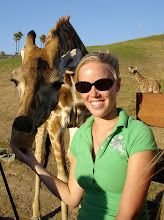This field season I have found the avifauna particularly eye-catching and intriguing. There are many, many varieties of birds here and I encounter a few in particular every day. Unfortunately, my knowledge of birds and my ability to identify them is pathetic, so I can't tell you many of the names, and most of the names that I will provide were told to me weeks ago and I didn't write them down so I may have gotten them wrong. Apologies to those who know better, and feel free to correct me.
First there are the weavers that live in a dense colony in the one fever tree here at the research center. They have woven dozens of gourd-shaped nests, many of which currently hang in the branches like Christmas ornaments, but most of which seem to be rejected and end up scattered on the ground below. They are yellow, and pretty, but I don't have a satisfactory photo yet.
There are many other birds that live around the research center. The most annoying are probably the doves that hang out on the banda roofs and call loudly, usually at 5:30, a half hour before I wake up. Other birds call in the morning as well, and it is by their calls that I can tell, when I wake up and it is still dark, if it is nearly time to get up or if I have a couple more hours of sleep.
My favorite research center bird is the roller (I think...possibly the lilac-breasted roller?). Such a gorgeous and cute bird! As my possibly made up name suggests, its chest is lilac and then the rest of it is a patchwork of deep blue, turquoise, burnt orange, gold, black and probably some other colors. There are one or two that show up periodically at the center and I feel lucky every time I see one. The photo below was taken out in the field.

Another of my long-time favorite birds is the crowned crane. It is elegant, as cranes tend to be, with a puff of gold feathers on its head. I remember first seeing one of these at the Louisville Zoo one summer during Zoo Camp. I was definitely a mammal girl even back then, but this bird caught my eye and when it came time to decorate t-shirts with puffy paint, I painted a crowned crane. Here is a crane I managed to capture in flight. It spotted a cheetah I was photographing and landed near it (but not too near) and proceeded to announce its presence to all of the would-be prey by calling loudly, hopping up and down, and flying quick circles above it. Very amusing to watch.


I have no idea what the next bird's name is, but it is a constant presence out in the field. I think they are ground-nesting birds. I first noticed them because they are always along the road when I am watching tommies, but it wasn't long before I noticed that the tommies were particularly vigilant to their alarm calls. These birds freak out whenever jackals (or humans, eagles, or other predators) are present and since tommies, especially fawns, are also vulnerable to jackals the tommies tend to pay attention when these birds speak up. Because I am interested in jackal-tommy interactions, I have also found myself looking around for the offending predator when I hear the birds' shrill cries.

Finally there are the ostriches. Enormous, gangly birds. I hadn't given ostriches much thought before this field season, but I am developing a mild dislike of them. They seem to be intent on disrupting my behavioral observations as they constantly walk between me and my subject animals and stop right in my line of sight. This happens with a suspiciously high frequency given the relatively low numbers of ostriches about. I think they do it on purpose. Besides their attempts to sabotage my research, they are just weird-looking. And not just because they have ridiculously long legs and necks. I think all of the features I find unappealing on them I would probably also find unappealing on any other bird, if those features were large enough for me to see them on other birds. Ostriches just take everything and make it way too big. In their favor I will say that their mating dances are amusing and it is eternally fascinating to me that you can actually see whatever they swallow travel all the way down their necks.

In non-bird news, research is going well, but is slowing down as of late because, well, the births are slowing down. The hartebeest have not really been productive since I got here, but the tommies were at first and now have died down. Both species are supposed to be year-round breeders and birthers with pronounced peaks near the rains. I think with last year's severe drought though, even these fairly drought tolerant species stopped cycling. According to Ol Pej's hartebeest monitoring data, hartebeest infants are about half as abundant as usual. I suspect I am seeing few non-peak tommy mothers because of the drought as well: if they stopped cycling and conceiving during the drought last year and then all started up again when the rains came, this year should be particularly synchronized for births, meaning that I am now running short on moms to watch. I am still out there every day watching moms with older infants and non-lactating females and am constantly on the lookout for new moms. I just don't see them. Nothing to do but to keep trying.

1 comment:
My favorite post so far! :P
the roller is sooooooooooo pretty and the picture of the crane is absolutely gorgeous!
gluck with the rest of the season and those annoying ostriches. I feel the same way about branches that hang right over the nest boxes.
Post a Comment